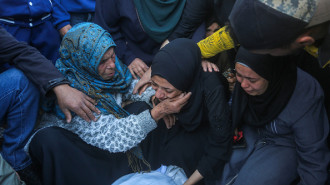Is Syria next in Israel's crosshairs after Quneitra incursion?
Israel has invaded and bulldozed farmland in parts of Syria's Quneitra province, following the withdrawal of a Russian monitoring force in the area with fears it might be attempting to annex the whole of the strategically important Golan Heights.
Israeli troops left parts of the Golan already occupied by Israel into Syrian territory close to the town of Kodna, in the southern Quneitra countryside, local sources told Al-Araby Al-Jadeed, The New Arab's Arabic-language service.
Bulldozers joined the Israeli invasion force and levelled 1,000 metres by 500 metres of farmland, including olive groves, and sealed it with barbed wire in a bid to "annex" the Syrian territory, Ayman Abo Muhammed Horani, spokesman for Horan Free Media, a monitor covering events in southern Syria, said.
Israel has illegally occupied parts of the Syrian Golan Heights since 1967.
The Syrian regime has denied the reports, describing it as "psychological warfare by the enemy".
Khalid Abaza, head of the ruling Baath Party in Quneitra, said on Sunday there was "no basis in truth" that Israeli forces had seized more Syrian territory in the area, according to the state-linked Al-Watan newspaper".
Activists and observers believe Israel's actions are linked to the 'Sufa 53' road project, which began in mid-2022, and cut as deep as 2km into Syrian territory.
This UNDOF line forms the outline for a broader buffer zone agreed between Israel and Syria - under the supervision of the UN, US, and USSR - in 1974, which is situated in Quneitra province.
Of the recent incursions, Syrian media activist Mohammed Saied told Al-Araby Al-Jadeed, The New Arab's Arabic-language sister edition, that Israeli encroachment into southern Syria "wasn’t new" but this time there were stark differences.
"In the past, they [Israeli soldiers] entered and carried out bulldozing operations and left, but this time they haven't [withdrawn]. Instead, they have annexed the area they encroached into on their side," he said.
Since Israel occupied two-thirds of the Syrian Golan Heights in 1967 it has established a network of military outposts, watchtowers, and settlements in the territory. In December 1981, the Israeli Knesset unilaterally decided to annex this section of the Golan, ignoring the views of the UN Security Council and the international community which regards its status as illegally occupied Syrian territory.
Experts believe that the Israeli invasion appears to be an attempt to extend this occupied land for infrastructure purposes.
"During previous years, Israel has carried out very limited incursions in order to remove natural obstacles like trees which prevent monitoring on the contact lines," said Wael Alwan, a researcher from the Jusoor for Studies Centre.
"Israel had decided to construct a secure road in Quneitra all along the contact line to prevent infiltration."
This has become a "security issue" of utmost importance for Israel following the 7 October attack last year, and is now pursuing a "multilayered" approach to monitoring, "as it has become evident that [a] technological [approach] was not enough".
"The expansion of the war, it seems, has made the Sufa 53 road insufficient for Israel inside Syrian territory," he said.
"Israel is heading towards a broad ground invasion of the whole of Quneitra and parts of Daraa, Suweida and rural Damascus provinces in southern Syria."
This comes after further reports of Israeli intentions to seize Arab land, as far as the Syrian capital Damascus.
Military expert Rashid Hourani believes the construction of the road in Syrian territory fulfills several of Israel's expansionist aims.
"Most of all it is to show other parties (Hezbollah and the Syrian regime) that it's capable of waging battles against them on its northern borders," he said.
"[It] may intend, through encroaching into Syrian territory, to open up corridors for the entry of more forces, and to secure their route from Syrian territory into Lebanese territory east of the Litani River."
He believes Israel's recent actions in Syria would have been coordinated with Russia and the US as "several agreements were previously concluded between these parties to ensure Israel's security, including the deal made regarding southern Syria in mid-2018".
Military analyst Colonel Abdul Jabbar Akidi, however, described Israel's incursion into southern Syria as "a continuation of the war of extermination in Gaza", adding that Israel had started a war against Hezbollah and "Iran's arms in the region", which comes after Russian forces withdrew from their positions in the area.
"It seems Tel Aviv is about to establish a security belt to keep the Iranian militias away and besiege them, and so cut off supply lines to Hezbollah," he said.
"[Syrian regime forces are] dilapidated in the south, where it has two brigades - the 161st and the 90th - while the regime recently dispatched reinforcements to the countryside of Aleppo and Idlib instead of sending them to the frontline in the occupied Golan."
This article is based on two articles which appeared in our Arabic edition by Mohammed Amin and Mohamad Karkas on October 14 and October 12. To read the original articles click here and here.




 Follow the Middle East's top stories in English at The New Arab on Google News
Follow the Middle East's top stories in English at The New Arab on Google News
![A group of Palestinians, foreign and Israeli activists gather to participated in an olive picking event on the land in the town of Battir, which is under threat of confiscation by Israel in Bethlehem, occupied West Bank on 8 November 2024. [Getty]](/sites/default/files/styles/image_330x185/public/2182930803.jpeg?h=199d8c1f&itok=__0LgGsa)

![People gathered around the rubble of destroyed houses to search for survivors [Getty]](/sites/default/files/styles/image_330x185/public/2024-11/GettyImages-2184733820.jpg?h=199d8c1f&itok=NiM1LO2f)